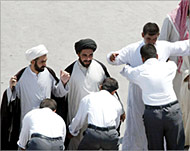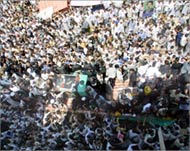Iraqis bury top cleric
Hundreds of thousands of Shia mourners flooded the steets of Najaf, as Iraqis laid to rest assassinated leader Ayat Allah Muhammad Baqir al-Hakim.

Al-Hakim was buried in the southern city of Najaf at around 2:15pm (1015GMT) on Tuesday, as two trucks and several shipping containers blocked off the sea of mourners, in an outpouring of collective grief.
By the grave site, middle-aged men wept openly. Al-Hakim’s brother Abd al-Aziz, who has a seat on the US-appointed 25-member interim Iraqi Governing Council, was also seen paying his final respects.
Mourners beat their chests and wailed in a traditional Shia ritual of grief. Volunteers sprayed water on grievers and bathtubs of drinking water lined the streets.
Waves of mourners made their way along the 15km route from Kufa to Najaf in blistering heat, as they accompanied Hakim’s coffin.
The cleric was killed last Friday in a double car bombing outside a mosque in Najaf, along with at least 82 other people.
Security tight
 |
|
Security included volunteers from |
Police officials expected as many as 500,000 people to attend.
Hundreds of security forces, including members of Al-Hakim’s private militia, the Badr Brigades, were deployed across Kufa and Najaf.
Three tiers of security were visible, including Iraqi police and volunteers from all religious parties. They were all armed with pistols and Kalashnikovs.
Some young people handed out tracts calling for revenge against the United States. Since US tanks rolled into Baghdad on 9 April, lawlessness and insecurity have gripped Iraq.
The signs of poor security climaxed last month in the bombings of the Jordan embassy, the UN headquarters in Baghdad and al-Hakim’s assassination.
Al-Hakim’s funeral procession began on Sunday in Baghdad.
Al-Hakim headed the Supreme Assembly of the Islamic Revolution in Iraq (SAIRI). He returned to Iraq from Iran in May, following 23 years of exile.
Divisions
|
|
 |
|
Fears of internal strife mounted |
Al-Hakim’s death was aimed at creating divisions within Iraq, said Dr Jabr Habib, a professor of political science at Baghdad University.
The Shia cleric made an effort to bridge gaps between different groups during his political career, Habib told our correspondent.
“Al-Hakim was both a politically and religiously prominent figure,” he said.
Habib said the cleric’s death came as a shock to Iraqis, especially since it was carried out on Friday, a holy day in Islam, and outside a mosque.
In related news, Ansar al-Islam leader Mulla Krekar denied any involvement in attacks in Najaf, the UN headquarters and Jordanian embassy in Baghdad.
Krekar, who now lives in Norway as a refugee, said he had not been in contact with Ansar al-Islam since last year.